Country guides

Things to do in Bulgaria
Bulgaria is a country rich in both natural and cultural attractions that, from a sightseeing perspective, caters to all tastes. Popular things to see and do in Bulgaria include myriad outdoor activities and opportunities for ecotourism, and the country's mountain scenery is unsurpassed. In addition to this natural splendour, Bulgaria has a rich history and folklore, and visitors can enjoy a wealth of archaeological sites, religious institutions, museums and ethnographic attractions.
The capital city, Sofia, boasts a number of the most popular sightseeing attractions in Bulgaria, including the Boyana Church, Alexander Nevsky Cathedral, St George Rotunda, the SS Cyril and Methodius National Library, and the St Sophia Church. Looming over the city is another great Bulgarian tourist attraction, the Vitosha Mountain, which provides a natural playground for visitors and locals alike in all seasons.
Bulgaria is half covered in mountains and it is the craggy beauty of its many ranges that most characterises the country in the global imagination. The more delicate, flowery mountains in the Rhodope range, which is scattered with picturesque villages, is complemented by the rugged splendour of the Pirin and Rila mountain ranges. Some of the most popular attractions in the mountainous regions are the 10th-century Rila Monastery, the Pirin National Park, the folk centre of Momchilovtsi village, and a number of ancient Thracian sites. This is, of course, in addition to the natural wonders of caves, hot springs, alpine lakes and dense forests.
Bulgaria's tourism tends to be dominated by its many beach and ski resorts but these holiday centres, enjoyable though they are, should only serve as a doorstep into the country, which has a lot to offer travellers, and is often overlooked as a great European destination.
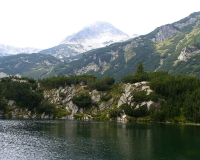
Pirin National Park
Situated in the highest reaches of the Pirin Mountains, Pirin National Park encompasses rugged alpine peaks that rise 8,202ft (2,500m) into the atmosphere with more than a hundred …
Pirin National Park
Situated in the highest reaches of the Pirin Mountains, Pirin National Park encompasses rugged alpine peaks that rise 8,202ft (2,500m) into the atmosphere with more than a hundred glacial lakes spread at their feet. The magnificent landscape is made up of old forests, waterfalls, caves and areas of limestone that are home to near-extinct flowers such as the edelweiss and Pirin poppy. Boasting an abundance of rare and endemic species of plants and animals, this unique national park is listed as a UNESCO World Cultural and National Heritage Site. Alpine mountaineering and skiing are popular activities in Pirin, as is hiking. The park boasts numerous, well-maintained hiking trails which wind through stunning scenery.
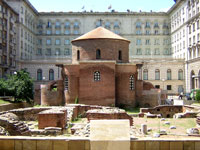
St George Rotunda
The rotunda church of St George is considered to be the oldest building in Sofia, dating back to the 4th century, and is situated amid the remains of the ancient Roman town of Serd…
St George Rotunda
The rotunda church of St George is considered to be the oldest building in Sofia, dating back to the 4th century, and is situated amid the remains of the ancient Roman town of Serdica. The St George Rotunda is famous for its exquisite architecture and layers of medieval frescoes that were discovered under a covering of plaster. The church functions as a museum and the magnificent dome is protected by UNESCO. It is located in a square enclosed by the Presidential Buildings and this makes the contrast between the ancient and the modern quite striking. There is a fair amount of information on the history and significance of the site available at the entrance, which is worth reading.
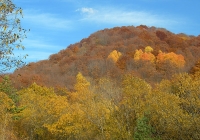
Vitosha Mountain
Rising above the capital city of Sofia, Vitosha Mountain is one of the symbols of the capital and is the most visited mountain in Bulgaria. Starting where the suburbs end, the whol…
Vitosha Mountain
Rising above the capital city of Sofia, Vitosha Mountain is one of the symbols of the capital and is the most visited mountain in Bulgaria. Starting where the suburbs end, the whole mountain has been designated a national park (the oldest in the Balkans), and is home to deer, bear, wild boar, fox and a variety of rare birds. Vitosha is known for its 'stone rivers', or moraines, piles of huge rounded granite boulders carried and deposited by glaciers thousands of years ago, as well as for its restorative mineral springs. Vitosha is popular during all seasons and the well-known resort of Aleko is the most established winter ski resort in the area.
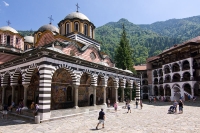
Rila Monastery
The biggest and most famous of Bulgaria's monasteries is situated in the northwestern part of the Rila Mountains and is one of the most significant monuments on the Balkan Peninsul…
Rila Monastery
The biggest and most famous of Bulgaria's monasteries is situated in the northwestern part of the Rila Mountains and is one of the most significant monuments on the Balkan Peninsula. Rila Monastery was founded by a hermit, St John of Rila, in the 10th century, and eventually became a monastic complex that played an important role in the spiritual history of medieval Bulgaria. Having survived fire, abandonment and plunder, the monastery fascinates visitors with its exquisite architecture, rich murals and icons and valuable museum collection, including old manuscripts, jewellery, textiles, church treasures and a library containing thousands of books. The Rila Monastery is a UNESCO World Heritage Site and a must-see attraction for anybody visiting Bulgaria.
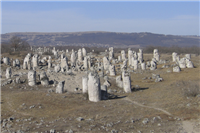
Petrified Forest
Just 13 miles (about 20km) west of Varna, Pobiti Kamani (the Petrified Forest) makes for an interesting and worthwhile daytrip. The origin of the stone columns, which measure up to…
Petrified Forest
Just 13 miles (about 20km) west of Varna, Pobiti Kamani (the Petrified Forest) makes for an interesting and worthwhile daytrip. The origin of the stone columns, which measure up to 23 feet (seven metres) in height, and 10 feet (three metres) in girth, remains a mystery, with geologists holding differing opinions about how they were formed. Regardless of their origin, however, Pobiti Kamani's columns are unique, and make for a fascinating, photo-filled excursion from Varna. Needless to say, visitors and locals come up with their own, more mystical explanations for the phenomenon, and many feel that it is a magical place.
Boyana Church
Located on the outskirts of Sofia, the Boyana Church complex is a UNESCO World Heritage Site, and one of Bulgaria's most important tourist attractions. The first of the three build…
Boyana Church
Located on the outskirts of Sofia, the Boyana Church complex is a UNESCO World Heritage Site, and one of Bulgaria's most important tourist attractions. The first of the three buildings that make up the Boyana Church complex was built in the 10th century, but it is the second building (constructed in the 13th century) that is the obvious tourist draw card. Containing frescoes painted in 1259, the second Boyana Church building is nothing less than the site of the most important collection of medieval eastern European art in the world. The paintings, which conform to a Byzantine aesthetic, are almost perfectly preserved and offer visitors a rare insight into the long, proud history of Bulgarian art and culture.
Website www.boyanachurch.org


